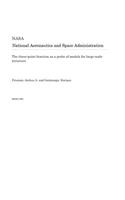
The Three-Point Function as a Probe of Models for Large-Scale Structure
Series:
The consequences of models of structure formation for higher-order (n-point) galaxy correlation functions in the mildly non-linear regime are analyzed. Several variations of the standard Omega = 1 cold dark matter model with scale-invariant primordial perturbations were recently introduced to obtain more power on large scales, R(sub p) is approximately 20 h(sup -1) Mpc, e.g., low-matter-density (n
NaN
VOLUME
English
Paperback

The consequences of models of structure formation for higher-order (n-point) galaxy correlation functions in the mildly non-linear regime are analyzed. Several variations of the standard Omega = 1 cold dark matter model with scale-invariant primordial perturbations were recently introduced to obtain more power on large scales, R(sub p) is approximately 20 h(sup -1) Mpc, e.g., low-matter-density (non-zero cosmological constant) models, 'tilted' primordial spectra, and scenarios with a mixture of cold and hot dark matter. They also include models with an effective scale-dependent bias, such as the cooperative galaxy formation scenario of Bower, etal. It is shown that higher-order (n-point) galaxy correlation functions can provide a useful test of such models and can discriminate between models with true large-scale power in the density field and those where the galaxy power arises from scale-dependent bias: a bias with rapid scale-dependence leads to a dramatic decrease of the hierarchical amplitudes Q(sub J) at large scales, r is approximately greater than R(sub p). Current observational constraints on the three-point amplitudes Q(sub 3) and S(sub 3) can place limits on the bias parameter(s) and appear to disfavor, but not yet rule out, the hypothesis that scale-dependent bias is responsible for the extra power observed on large scales. Frieman, Joshua A. and Gaztanaga, Enrique Unspecified Center NAGW-2381...
Price Comparison [India]
In This Series
Bestseller Manga
Trending NEWS




















